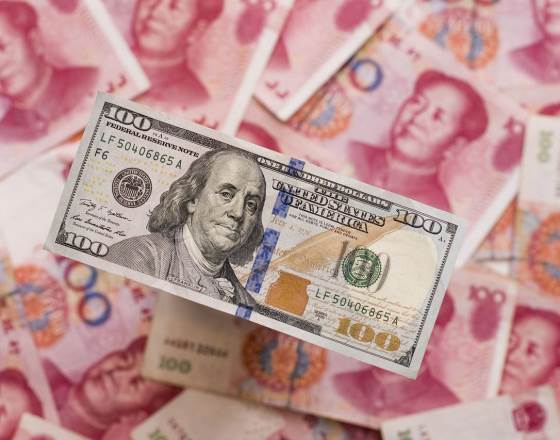
A decade after Beijing lifted its official peg to the dollar, its control of the yuan could set back ambitions to broaden use of the currency
China’s yuan is on track to post one of its longest streaks of stable trading in a decade, just as its financial markets reel and growth sputters, reflecting how disconnected the currency remains from the country’s hefty challenges.
Ten years ago Tuesday, the People’s Bank of China unpegged the yuan from the U.S. dollar. Yet the currency remains tightly controlled, with the central bank regularly buying and selling it in the domestic foreign-exchange market to maintain a desired level.
That firm grip has steadied the yuan despite a ream of unsettling news out of China, ranging from a selloff that had knocked trillions in value from Chinese equities tosecond-quarter growth of 7%, matching the economy’s slowest rate of expansion in decades. Since May, the Chinese currency has barely moved against the U.S. dollar, declining 0.01%.
“Even though they don’t have a formal peg now, this is the closest it has been to such a period of stability,” said Khoon Goh, a currency strategist at Australia and New Zealand Banking Group Ltd. in Singapore. Despite recent moves in global financial markets, “the [Chinese yuan] has remained remarkably stable.”
The currency’s unusual stability and Beijing’s careful management could set back broader economic reforms aimed at shepherding the yuan toward greater international clout, analysts say.
The sentiment echoes similar concerns about Beijing’s closely engineered stock-market rescue. China put in place a range of measures—from halting initial public offerings to preventing some stock sales—that many have said could delay China’s goal of opening up its markets.
China doesn't “want to see the market spooked one way or another,” said Sacha Tihanyi, a senior currency strategist at Scotiabank in Hong Kong. “The equity market meltdown created a whole new reason to clamp down on [the currency] some more.”
Around the globe, meanwhile, a renewed debt crisis in Greece, collapsing gold prices and divergent monetary policies among global central banks have whipsawed currency markets. The Federal Reserve’s plans to raise short-term interest rates later this year sent the dollar to its highest in over a decade earlier this year against the Japanese yen. That pushed other Asian currencies to depreciate more than 3% against the U.S. dollar since early May.
Over the past year, China’s flagging economy has led Beijing to undertake aggressive stimulus measures. But Beijing’s ambitions for the yuan—and larger goals to open up its markets—have kept it from devaluing the currency, a tactic often used by countries seeking to bolster their exports, and thus economic growth.
“It is quite clear that [China] is not using the currency as a way to try and provide stimulus for the economy,” Mr. Goh said.
Rather, China is trying to avoid mistakes made by many other emerging-market countries. By opening up their capital accounts too fast, allowing funds to flow freely across their borders, they laid the groundwork for furious surges and rapid depreciations in their currencies, such as those in Thailand during the 1990s.
To be sure, the recent pattern follows two years of relatively volatile trading as Beijing tried to make its currency more market-driven, ending one-way bets on the yuan’s appreciation and stemming speculative money flows.
A big factor behind Beijing’s push for stability is a desire for inclusion in the International Monetary Fund’s Special Drawing Rights, an exclusive basket of currencies comprised of the U.S. dollar, the euro, the British pound and the yen that make up the fund’s emergency lending reserves. The IMF will consider a decision on including the yuan later this year.
It also highlights officials’ efforts to pivot the economy toward growth-based consumption, rather than the export-oriented expansion that would benefit from a cheaper yuan. In the face of a fitful stock market and collapsing growth, a stable currency, too, could encourage offshore investors into Chinese assets as Beijing tries to stem capital outflows.
After years of fixing its currency against the U.S. dollar, the Chinese central bank dropped its official peg in 2005, revaluing the yuan overnight. The move helped integrate China’s rising economy into global markets and allayed tensions with trading partners frustrated by what they considered a too-cheap currency that gave Chinese manufacturers an unfair advantage. The yuan has broadly appreciated 30% since the currency was revalued by 2% to 8.11 yuan per U.S. dollar on July 21, 2005.
Now, China’s central bank sets a daily reference rate for the yuan against the U.S. dollar and allows the currency to trade 2% above or below it, barring a two-year period during the global financial crisis when Beijing effectively relinked its currency to 6.83 yuan per U.S. dollar as an emergency measure.
The recent calm has even withstood a volatile stretch for the U.S. dollar in recent months, as patchy economic data led to fluctuating expectations of a rise in U.S. rates.
Declining reserves of foreign currency at the People’s Bank of China suggest that the central bank has been buying the yuan to keep it strong and steady against the dollar. Earlier this month, data from the central bank showed its foreign-exchange holdings in the second quarter fell $40 billion to $3.69 trillion from the previous quarter.
But even after a decadelong reform process, global usage of China’s yuan remains “low relative to China’s share of global GDP, trade and investment,” analysts from HSBC wrote in a note to clients Monday.
